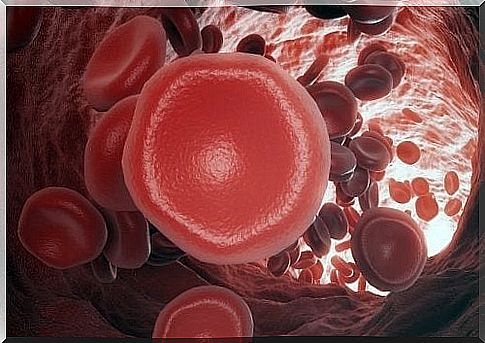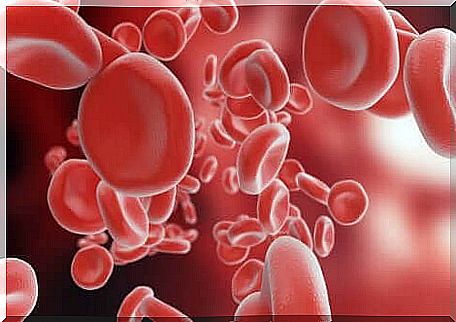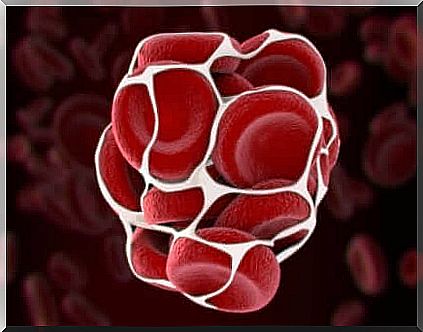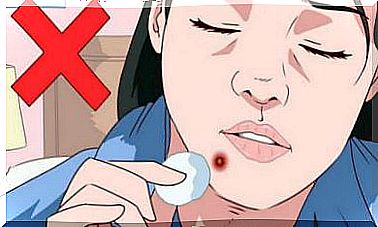Blood Clotting: What Is It And How Does It Happen?

Coagulation is the process by which blood passes from its natural liquid state to a gel state, forming a clot. It is a small mass of blood that forms when platelets, red blood cells and some proteins stick to each other.
It is important to distinguish the clot from the thrombus and the embolus. A thrombus is a clot that adheres to the wall of a blood vessel. Emboli, on the other hand, are clots that circulate in the bloodstream and block the passage of blood by blocking in one part of the body.
Blood clotting is essential for life. All mammals, in fact, have a similar coagulation system. In today’s article, we explain everything you need to know about this physiological process.
What is coagulation?
First of all, we need to know a little about the physiology of the blood. In its natural state, blood flows in liquid form, without assuming the gelatinous state. The vascular walls are healthy and intact and no substance is activated that triggers the formation of clots.
In these cases, the anti-coagulation and coagulation processes are perfectly balanced. In these two processes there are many proteins that regulate this balance, called homeostasis.
When a blood vessel is damaged, a chain reaction is triggered in which the activation of a series of proteins leads to the formation of a clot. This chain of events is called the coagulation cascade.
More than 10 different proteins are involved, collectively called “coagulation factors”. These proteins are normally found in the bloodstream.
The physiological process of blood coagulation

In summary, the steps that take place in a blood clotting process are as follows:
- First, a small damage must occur in the wall of a blood vessel (wound). This causes bleeding (a term for blood leaking from the vessels, regardless of the amount).
- Following the bleeding, the blood vessels contract. This vasoconstriction is an attempt to restrict blood flow to avoid losing large amounts through the wound.
- Platelets are activated immediately. These are small cells that circulate in the blood and which, adhering to each other at the point where the wound occurred, form a plug. At this point, one of the most important clotting factors is activated: the Von Willebrand factor.
- Finally, the other clotting factors activate the production of fibrin. This very resistant substance allows to form a kind of network that keeps the platelet plug solid and stable. As the wound heals, the plug that has formed (clot) dissolves. In this way the balance is restored and the vessel recovers its usual state.
What are the diseases that affect blood clotting?
As already mentioned, blood clotting is a fundamental physiological process for life. When an element of the coagulation cascade does not work properly, various diseases can arise. Let’s see some examples.
1. Von Willebrand’s disease

It is the most common disorder that affects blood clotting. People affected by this pathology have a dysfunction in the coagulation factor from which it takes its name. As indicated, von Willebrand factor is the protein that helps platelets clump together.
This disease affects about 1% of the population. However, the symptoms are mild and few people are correctly diagnosed. Some of the symptoms are:
- Prolonged bleeding from the nose.
- Abundant menstruation in women.
- Excessive bleeding if there is a lesion or blood in the urine or stool.
2. Hemophilia: the coagulation disease
This is a rare blood clotting disorder that affects people with a factor VIII or IX deficiency. These people experience excessive bleeding following an injury because the blood does not clot properly.
It is a hereditary disease, which can be very serious. When internal bleeding occurs, organs and tissues can be damaged, which endangers the person’s life.
Hemophilia is a disease that was particularly widespread among members of royal families in the 19th century. For example, the son of the last Russian tsars was a hemophiliac. Many studies have tried to identify the genetic origin of this pathology.
In conclusion
Blood clotting is a complex process that helps keep us alive. It is of fundamental importance to study its functioning in order to treat any deficiencies in one of the phases of this mechanism.









